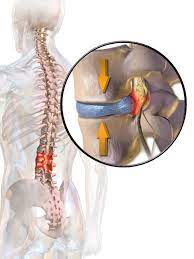What is Ankylosing Spondylitis?
Ankylosing Spondylitis is a type of arthritis that primarily affects the spine, causing pain and stiffness. It can also affect other joints and organs, such as the hips, knees, and eyes.
The condition is caused by inflammation, which over time can lead to fusion of the vertebrae in the spine. This can cause a loss of flexibility and mobility in the affected area, making it difficult to perform everyday tasks.
Symptoms of Ankylosing Spondylitis
Ankylosing Spondylitis is a chronic condition that primarily affects the spine, causing inflammation and stiffness.
The most common symptom of Ankylosing Spondylitis is lower back pain, which can be severe and persistent.
This pain may also radiate to other areas of the body, such as the hips or buttocks.
In addition to back pain, people with Ankylosing Spondylitis may experience stiffness in the spine and other joints, especially in the morning or after periods of inactivity.
This stiffness can make it difficult to perform everyday tasks, such as getting out of bed or bending down to tie shoes. Fatigue is another common symptom of Ankylosing Spondylitis, which can make it challenging to maintain an active lifestyle.

Diagnosing Ankylosing Spondylitis
Ankylosing Spondylitis can be difficult to diagnose because its symptoms are similar to those of other conditions. However, doctors will usually start with a thorough physical exam and medical history to rule out other possible causes of your symptoms.
Imaging tests such as X-rays, MRI scans, and CT scans can be used to detect inflammation and damage in the spine and other affected joints.
Blood Investigations:
Presence of HLA B27 genetic marker:
T Its presence in the blood is not sufficient to make the diagnosis. The test is quite helpful when the diagnosis of the condition is not clear.
Routine blood tests, such as CBC and ESR, may suggest the presence of active or chronic inflammation in the body. Blood tests can also be performed to check for markers of inflammation and genetic factors that are associated with Ankylosing Spondylitis.
Erythrocyte sedimentation rate (ESR) is normal or can be mildly elevated. ESR is more likely to be elevated with active inflammation.
- C-reactive protein may be elevated.
- Serum alkaline phosphatase may be elevated in active bone affection.
Go for the RA test and ANA test to rule out Rheumatoid Arthritis and lupus.
Treatment Options for Ankylosing Spondylitis
Ankylosing Spondylitis is a chronic inflammatory disease that primarily affects the spine and sacroiliac joints. It can cause pain, stiffness, and limited mobility, which can impact daily life and quality of life.
There are several treatment options available for Ankylosing Spondylitis, including medication, physical therapy, and lifestyle changes.
Nonsteroidal anti-inflammatory drugs (NSAIDs) are often used to reduce inflammation and pain.
Biologic medications, such as tumor necrosis factor (TNF) inhibitors, can also help reduce inflammation.
Physical therapy can improve flexibility and strength, while lifestyle changes like exercise and a healthy diet can also help manage symptoms and improve overall health.
Living with Ankylosing Spondylitis
Managing Ankylosing Spondylitis can be challenging, but it’s important to remember that there are many things you can do to improve your quality of life.
One of the most effective ways to manage symptoms is through exercise.
Regular physical activity can help reduce pain and stiffness, improve flexibility, and boost overall health. Consider working with a physical therapist or personal trainer to develop an exercise plan that works for you.
In addition to exercise, stress management techniques can also be helpful for people with Ankylosing Spondylitis. This may include practices like meditation, deep breathing, or yoga.
Self-care is also important, and may involve activities like getting enough rest, eating a healthy diet, and taking time to relax and recharge.
By taking care of yourself both physically and mentally, you can better manage your symptoms and enjoy a more fulfilling life.




